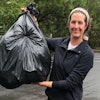McDonald’s comes to the Orange County Convention Center every two years for its Worldwide Convention, a gathering of 15,000 owner-operators, franchisees, corporate staff, and suppliers from 119 countries. The event offers a mix of general sessions, learning experiences, an exhibit hall, and entertainment. But along with the standard offerings, the company looks for opportunities to innovate and use the event to demonstrate best practices for its attendees. In 2008, that led to the creation of a sustainability program, which has continued and grown since then. At this year’s convention, held April 28 to May 1, McDonald’s focused on using technology as an engagement strategy for both attendees and non-attendees beginning months before the actual event.
The effort began in January with the launch of the convention website on the company’s intranet. In past years the site had focused strictly on logistical information, but this year the company created an interactive news feed, similar to Facebook, where it shared previews of event content, facts about the convention, and insights from senior leadership, and it invited users to comment and "like" posts.
“It was a more digestible news-bite type format rather than heavy reading. It’s categorized into topic areas and you can search and filter by topic,” says Lisa Fingerhut, McDonald’s engagement project manager. “It features messages that are designed to resonate with and align the entire system. So while in previous years users would visit the website if they were a convention attendee, we are now really marketing it to non-attendees as well.” The company also used the website as a marketing tool for the convention by inviting users to answer questions such as, “What would you tell an owner-operator about the convention?” or asking them to upload videos showing what the convention theme of “As One” means to them.
Also new this year, the website offered live streaming of the event’s four general sessions and on-demand access of the programs by the end of each day. To date, the site has garnered more than 35,000 unique visitors and nearly 400,000 individual page views.
The second phase of the strategy involved the event’s mobile app, which in the past was also used primarily for logistical and navigation support, but this year became an engagement tool. In the days leading up to the convention, organizers sent out a video welcome message from singer and music producer David Foster, who served as M.C. for the convention's final-night concert. The message received more than 22,000 page views. “It really generated a lot of excitement,” Fingerhut says. Each morning of the convention, users received a “What’s Hot” message through the app, which received about 16,000 views each day and replaced the email blasts that were used in the past.
To address the needs of its international audience, organizers developed separate communication systems within the app aligned with its four worldwide communication teams. “We were able to target push notifications to specific attendee types, so while I had the U.S. messages on mine, I did not receive others from other parts of the world,” Fingerhut says.
The app also offered a closed social network, called WWChat, that allowed attendees to check in to event locations, share photos, and post comments. Large screens in the exhibit hall displayed both this internal chat stream and also posts from external networks such as Facebook, Instagram, and Twitter, using an aggregation system from Mass Relevance. “We are showcasing the voice of our customer; we are showing the reality of the conversations, both the brand love as well as challenges and opportunities,” Fingerhut says.
The convention also used Cisco’s Connected Mobile Experience system to track attendees as they moved throughout the convention center. The Wi-Fi-based system provided real-time data on traffic patterns, dwell time, and most-visited exhibits. At the end of the first day, Fingerhut says the data showed that as the crowds emptied out of the keynote session at lunch time, the majority went to the restaurants on one side of the exhibit hall, leaving the other side less crowded. So the next day they changed the traffic pattern coming out of the keynote to disperse the crowd more evenly.
“Our objective for using digital throughout the convention was to help attendees really understand that the needs and behaviors of our customers are changing, and the use of mobile technology will be an effective marketing and communication tool for the future,” Fingerhut says.
McDonald’s worked with Kindle Communications to develop and implement the engagement strategy.

























